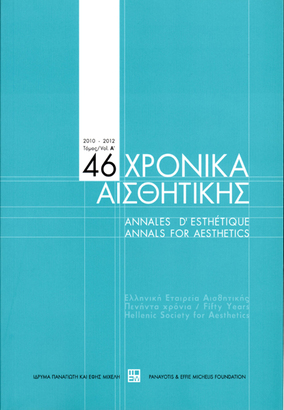Ο «αναίσθητος χρόνος» εν τη τέχνη : μια αισθητική ερμηνεία του Αριστοτέλους
Part of : Χρονικά αισθητικής : ετήσιον δελτίον της Ελληνικής Εταιρείας Αισθητικής ; Vol.Γ-Δ, 1964, pages 60-61
Issue:
Pages:
60-61
Parallel Title:
The «αναίσθητος χρόνος» in the art : an aesthetical interpretation of Aristotle
Section Title:
Ανακοινώσεις των Ελλήνων συνέδρων κατά το Ε' Διεθνές Συνέδριον Αισθητικής
Author:
Abstract:
In a passage of Aristotle the following is mentioned: «Το γάρ καλών εν μεγέθει καί τάξει εστίν. διό ούτε τιάμμικρον αν τι γένοιτο καλόν ζφον (συγ- χειται γάρ ή θεωρία εγγύς τον αναίσθητου χρόνου γινόμενη) ούτε παμμέγε- θες (ον γάρ άμα ή θεωρία γίνεται άλλ’ οϊχεται τοϊς θεωρονσι το εν καί το δλον εκ τής θεωρίας) οϊον εΐ μυρίων σταδίων εϊη ζφον» (Poetics 7. 1450 b 36).In the above passage of Aristotle it is shown that the philosopher from Stagira accepts the theory of the Species, namely of form, in which the sense of beauty is expressed by external elements and characteristics, as mentioned above, that is to say, that the meaning of beauty depends upon size and order, and consequently neither an extremely small animal can be beautiful, since its appearance is confused in a time that can not be sensed, nor extremely great, since its appearance is not contemporary, for unity and totality of sight are missing for the spectators: for example; if it were an animal of two thousand kilometers.Besides the above external elements, as concepts of shape and order which determine the conception of beauty there is even a third element, which is very closely related to the others and that is the conception of «time», since without it, it is not possible, as we will see below, that something can be characterized as beautiful, even if the other two are provided.The third element therefore, the «άναίσθητος χρόνος» is not the explanation of the first conception, that is to say of shape. But the above meaning of shape, being now in time a logical shape, that is to say, «determined» does not include in itself neither the meaning of «πάμ- μικρον» nor the meaning of «παμμέγεθες» and therefore it gives the meaning of proportion, that is of symmetry. But all these correspond to the second meaning, that is «order» which indicates the meaning of symmetry.
Subject:
Subject (LC):




